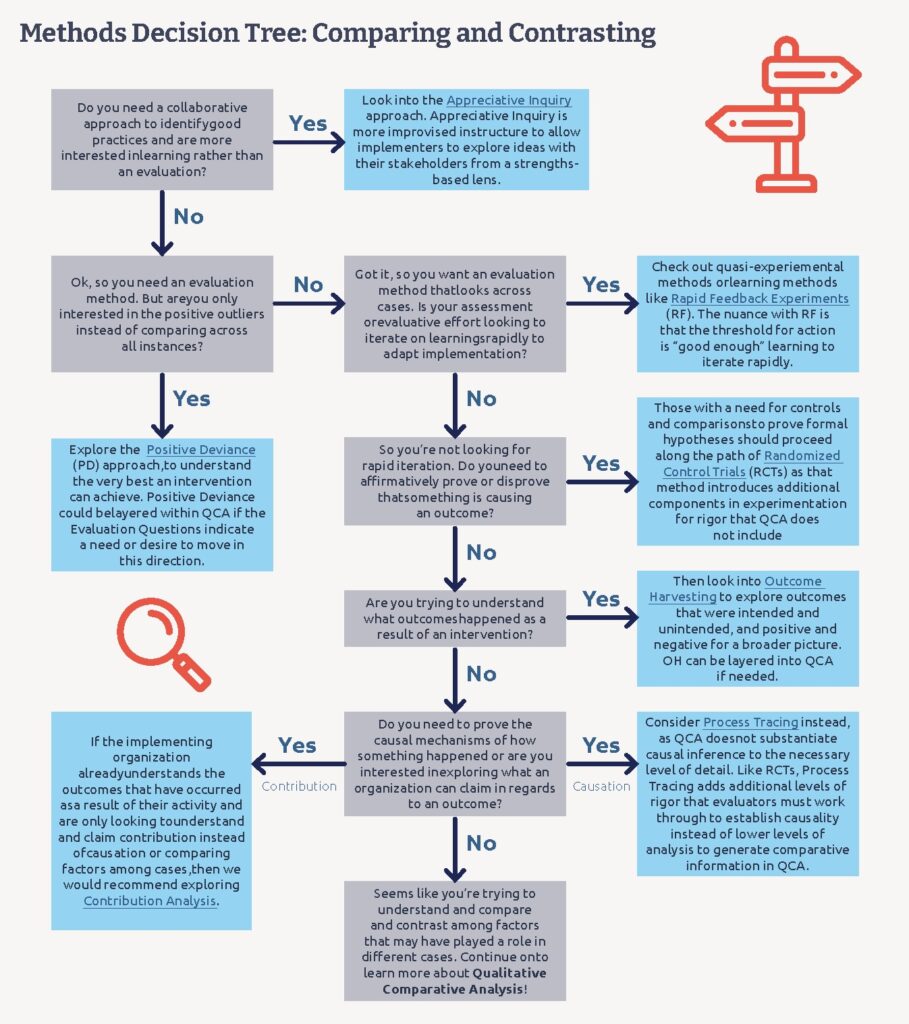Authors: Chelsie Kuhn, CLAME Specialist & Alison Harrell, CLAME Specialist
Headlight Consulting Services is excited to share our second Methods Memo in a series of more robust products intended to provide how-to guidance for professionals of all levels to implement stronger CLAME practices. This particular memo’s goal is to provide evaluators with practical guidance for deciding when Qualitative Comparative Analysis (QCA) is a good fit and how to contextualize and implement the method. Its contents may also be relevant to organizations that are looking to establish and improve their qualitative methods considerations and practices.
When designing an evaluation, it is important to not just think immediately of the data collection approaches the evaluator might take (e.g., mixed methods including both quantitative and qualitative data) and sampling strategies (e.g., purposive, snowball, stratified random, cluster, etc.), but to first find the evaluation method that will best help structure the overall evaluative effort to appropriately answer the identified evaluation questions.
QCA is an evaluation and research method that, “enables the analysis of multiple cases in complex situations, and can help explain why change happens in some cases but not others,” (Simister and Scholz, 2017). The analysis is based on identifying a set of cases (individual activities or interventions) that have some common alignment and analyzing each case according to a set of factors to establish a cross-case comparison. Qualitative Comparative Analysis originated as a new method in the social sciences in the late 1980s to help researchers compare cases and parse through multiple variables to explain how cases were similar to and different from one another (Marx, Rihoux, and Ragin, 2013).
The most unique aspect of QCA is the comparison it allows among (and within) cases. Rather than compiling a set of separate case studies and observationally noting the similarities and differences, QCA offers a more rigorous approach to analyzing similarities, differences, influencing factors, etc. across cases and identifying the factors critical for success or achieving desired outcomes. QCA is not a one-size-fits-all evaluation method and should only be chosen if it will meet the desired aims of the evaluation.
The Qualitative Comparative Analysis Methods Memo is organized as use-focused modules, and we start off with a brief introduction to refresh readers on what QCA is, when it is appropriate to use this method, how to implement QCA, competencies that an evaluator needs for implementation, and our top tricks and tips. From there, we dive into examples of how QCA has been used in the development field along with a comparison between those two cases to draw out what makes them a good fit for QCA application. These subsections also include a brief history of the method, a decision tree for evaluators to consider, and visuals to depict important details for factor selection. This Decision Tree is not exhaustive, and we would encourage anyone making this decision to read up on evaluation methods on BetterEvaluation.org and through our new practical application Methods Memos to learn more.

We hope that this Methods Memo will help inspire evaluators, project leaders, and donors alike to start or continue applying the Qualitative Comparative Analysis evaluation method where appropriate and to fuel further innovation, rigor, and adaptation in our collective evaluation work. If you find this resource useful, we would love to hear about what you have learned and how you have applied it in your own work. And if your organization is interested in applying this method but you need additional support from experienced evaluators, Headlight would love to support you! For more information about our services, please email info@headlightconsultingservices.com.





Comments
no comments found.